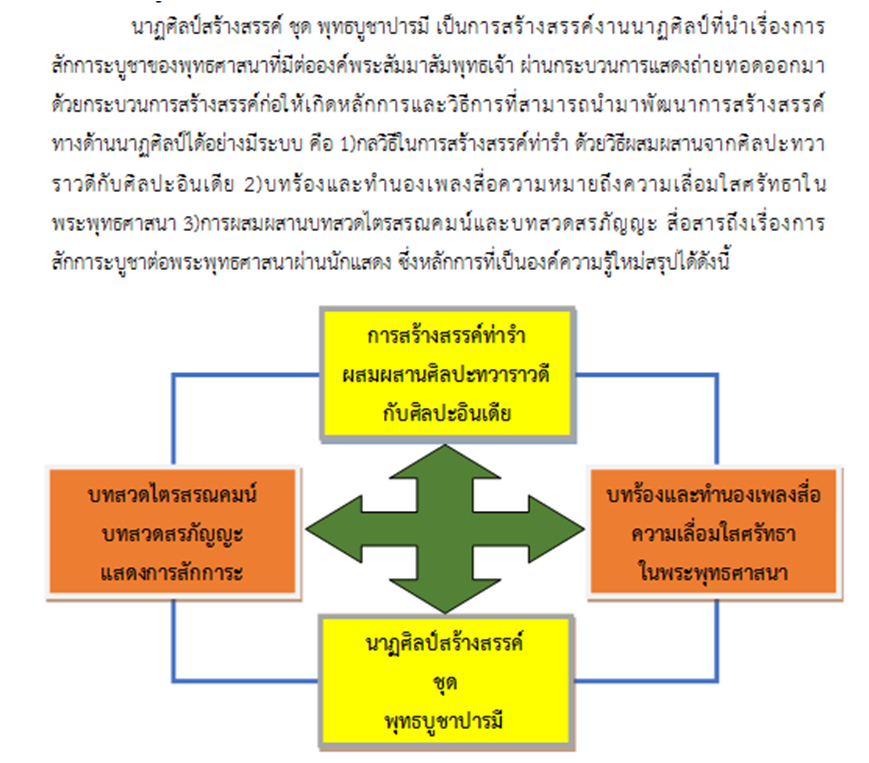THE CREATIVE DANCE: BUDDHA BUCHA PARAMEE
Main Article Content
Abstract
The objectives of this research article are 1) to design dance process, the creative works of Buddha Bucha Paramee, 2) to create elements for displaying the creative works of Buddha Bucha Paramee by using a qualitative research methodology from the study of documents and the field. The research tools were the observation form and the interview form. Sample group that used in this research consisted of interviewing 16 knowledgeable people, 10 practitioners, and 20 general people. The research results were analyzed by descriptive method.
The results of the research were as follows: 1.design of “Buddha Bucha Paramee” dancing posture was presented as Dvaravati and Indian dancing to represent the meaning of “bucha” (worship) to Buddha’s image according to Theravada Buddhism principle. “Amis Bucha” (Amis worship) was the warship with flowers (lotus) starred by ten male and female dancers. The performance was divided into3 phases including phase 1 : Worship, phase 2 : Buddha Pratarnphorn(God’s bless), and phase 3 : Celebrating Buddha Paramee.Todesign dancing posture, we applied 3 dancing principles including 1) imitating dancing posture from sculpture and painting, 2) imagination based on concept of Dvaravati (Mon) integrated with Indian arts, and 3) creating new dancing posture integrated with standard dancing posture. 2.The performance consisted of 5 elements including 1) lyric, rhythm and music, 2) the actors, 3) costume and accessories, 4) props, 5) area on the stage and deployment. “Buddha Bucha Paramee” performance had been assessed by experts and veterans using focus group discussion and we found that “Buddha Bucha Paramee” performance had good quality, completeness and beauty according to the concept of creating dancing and music aesthetics
Article Details

This work is licensed under a Creative Commons Attribution-NonCommercial-NoDerivatives 4.0 International License.
References
กระทรวงวัฒนธรรม. (2561). พระพุทธศาสนา. สืบค้นเมื่อ 25 มีนาคม 2563. จาก http://www.m-culture.go.th/
เจนจบ ยิ่งสุมล. (2543). พระพุทธรูปสำคัญในเมืองไทย. กรุงเทพมหานคร : สำนักพิมพ์ประพันธ์สาส์น.
เชษฐ์ ติงสัญชลี. (2553). ลวดลายในศิลปะทวารวดี: การศึกษา “ที่มา”และการตรวจสอบกับศิลปะอินเดียสมัยคุปตะ-วกาฏกะ. นครปฐม : สถาบันวิจัยและพัฒนา มหาวิทยาลัยศิลปากร.
ญาณภัทร ยอดแก้ว และแพรภัทร ยอดแก้ว. (2553). การศึกษาวิเคราะห์คุณค่าแท้และคุณค่าเทียมของการบูชาพระพุทธรูปในสังคมไทย. การประชุมวิชาการ มหาวิทยาลัยเกษตรศาสตร์วิทยาเขตกำแพงแสน ครั้งที่ 7. มหาวิทยาลัยเกษตรศาสตร์ วิทยาเขตกำแพงแสน. 7-8 ธันวาคม 2553. 1257–1271.
ณัฏฐนันท์ จันนินวงศ์. (2556). การออกแบบลีลานาฏศิลป์ไทยของอาจารย์สุวรรณี ชลานุเคราะห์ ศิลปินแห่งชาติปี พ.ศ. 2533. วิทยานิพนธ์ปริญญาศิลปศาสตรมหาบัณฑิต สาขาวิชานาฏยศิลป์. คณะศิลปกรรมศาสตร์ : จุฬาลงกรณ์มหาวิทยาลัย.
ปรเมธ ศรีภิญโย, สนั่น ประเสริฐ, เทพพร มังธานี. (2560). การบูชาตามหลักพระพุทธศาสนาเถรวาท. การประชุมวิชาการระดับชาติ ครั้งที่ 4 และนานาชาติ ครั้งที่ 2. มหาวิทยาลัยจุฬาลงกรณราชวิทยาลัย วิทยาเขตขอนแก่น. 31 มีนาคม 2560. 1273-1284.
ผาสุข อินทราวุธ. (2530). พุทธศาสนาและประติมานวิทยา. กรุงเทพมหานคร : ภาควิชาโบราณคดี คณะโบราณคดี มหาวิทยาลัยศิลปากร.
ผาสุข อินทราวุธ. (2548). สุวรรณภูมิจากหลักฐานทางโบราณคดี. กรุงเทพมหานคร : ภาควิชาโบราณคดี คณะโบราณคดี มหาวิทยาลัยศิลปากร.
ผาสุข อินทราวุธ. (2551). Dvaravati Dharmacakra(ทวารวดีธรรมจักร). กรุงเทพมหานคร : ภาควิชาโบราณคดี คณะโบราณคดี มหาวิทยาลัยศิลปากร.
พระเทพสุวรรณโมลี (สะอิ้ง สิรินนฺโท) ผู้ให้สัมภาษณ์. 10 กันยายน 2563. ณ วัดป่าเลไลย์ จังหวัดสุพรรณบุรี.
พระเทพโสภณ (ประยูร ธมฺมจิตฺโต). (2544). พระพุทธศาสนาในสถานการณ์โลกปัจจุบัน. กรุงเทพมหานคร : โรงพิมพ์มหาจุฬาลงกรณราชวิทยาลัย.
พัชรินทร์ สันติอัชวรรณ. (2561). สุนทรียภาพในระบำโบราณคดี. วารสารจันทรเกษมสาร. 24(46). 20-25.
สิริชัยชาญ ฟักจำรูญ. (2546). ดุริยางคศิลป์ไทย. กรุงเทพมหานคร : สำนักพิมพ์สถาบันไทยศึกษา จุฬาลงกรณ์มหาวิทยาลัย.
สุรพล วิรุฬห์รักษ์. (2547). หลักการแสดงนาฏศิลป์ปริทรรศน์. กรุงเทพมหานคร : สำนักพิมพ์แห่งจุฬาลงกรณ์มหาวิทยาลัย.


